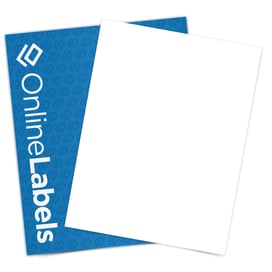Recognizing Exactly How Blank Labels Work to Enhance Your Labeling Experience
Comprehending the auto mechanics of blank labels is necessary for enhancing your labeling methods throughout numerous contexts. To totally grasp exactly how these labels can change your procedures, one have to think about the different types readily available and the myriad methods they can be personalized to match particular demands.

Benefits of Utilizing Blank Labels
Blank labels supply a versatile option for various labeling needs, making them very useful in both individual and professional settings. Their flexibility allows individuals to create tailored labels tailored to details demands, boosting organizational performance. Whether used in office, retail environments, or industrial applications, blank labels assist in the identification and classification of products, documents, and personal items.
One substantial benefit of blank labels is their cost-effectiveness. By permitting users to print only the labels they need, waste is reduced, and inventory management becomes extra manageable. Furthermore, blank labels are suitable with numerous printing approaches, including inkjet and printer, making them accessible for various customers.

Moreover, making use of blank labels streamlines the procedure of upgrading details, as individuals can quickly publish brand-new labels to change obsolete ones, guaranteeing that all products and files are precisely classified. On the whole, blank labels offer a practical and effective labeling solution for diverse applications.
Kinds of Blank Labels Available
What options are offered when it concerns blank labels? Blank labels be available in a selection of types, each fit for different applications and choices. One of the most usual types consist of paper labels, which are functional and cost-efficient, making them suitable for day-to-day usage. They are readily available in numerous finishes, such as matte and glossy, enabling aesthetic adaptability.
Another prominent choice is artificial labels, often made from products like polyester or vinyl. These labels are known for their durability and resistance to water, chemicals, and tearing, making them suitable for rough environments. They are commonly made use of in commercial setups or for labeling items that may be subjected to wetness.
In addition, there are thermal transfer labels, which call for a printer that utilizes heat to move ink onto the label surface area. These labels are favored for their high-grade print and durability.
Lastly, specialized labels cater to details needs, such as detachable labels for short-lived usage or high-temperature labels for extreme problems. Understanding these alternatives allows individuals to choose one of the most proper blank tag for their one-of-a-kind labeling needs.
Modification Options for Labels
A wide selection of customization alternatives is readily available for labels, allowing individuals to tailor them to details requirements and branding requirements. Users can pick from various sizes, shapes, and products to ensure that the labels efficiently fit their desired purpose. Usual products consist of paper, polyester, and vinyl, each using different degrees of toughness and aesthetic appeal.
Shade alternatives play a vital role in modification, allowing brands to preserve uniformity with their company identity. Customers can pick from a spectrum of shades or even choose custom-made printing to match certain branding elements. Additionally, labels can be published with distinct designs, logo designs, and message, enhancing brand name recognition and visual go to this site effect.
One more important element is the option of adhesive. Tags can be created with long-term, detachable, or repositionable adhesives, depending upon the application requirements. This adaptability permits effective labeling solutions throughout different environments, from retail to commercial settings.

Tips for Effective Labeling
Effective labeling exceeds modification; it likewise involves strategic considerations that improve functionality and interaction. To accomplish efficient labeling, begin by clearly defining the purpose of each tag. Think about the details that requires to be conveyed and ensure it exists in a simple way. Using succinct language and preventing lingo can dramatically boost comprehension.
Next, prioritize exposure by selecting appropriate colors and fonts. High comparison between text and background improves readability, while larger fonts facilitate fast identification. Furthermore, ensure that labels are positioned in a regular and rational fashion, making it look these up easier for individuals useful site to situate and interpret information.
Think about the toughness of labels as well. Select products fit for the certain atmosphere where the labels will be utilized, whether it be inside or outdoors. Waterproof or tear-resistant alternatives may be necessary relying on the context.
Last but not least, on a regular basis testimonial and upgrade your labels to mirror any adjustments in information or use. This aggressive method not just preserves clarity yet also avoids confusion with time. By adhering to these suggestions, you can maximize the effectiveness of your labeling initiatives, ensuring they offer their intended objective efficiently.
Applications of Blank Labels
Blank labels supply many applications across different sectors, making them a vital tool for organization and communication. These versatile labels are typically used in warehouses for stock management, enabling services to conveniently recognize and track products. By applying blank labels to storage bins, shelves, or pallets, firms can streamline their operations and decrease the likelihood of mistakes.
In the health care industry, blank labels play a critical duty in identifying medicines and clinical products, making sure appropriate identification and usage. Personalized labels can consist of important information such as dose, expiration dates, and individual information, improving safety and security and conformity.
In retail, blank labels help in rates products, supplying promos, or identifying rack locations, which ultimately improves the consumer experience. They permit quick updates to pricing or product details without the requirement for pre-printed labels.
In addition, blank labels are advantageous for personal use, such as organizing office, crafting, or classifying food containers. Their flexibility allows individuals to create tailored services that meet certain requirements. Overall, the applications of blank labels are extensive, highlighting their importance in promoting performance and quality in different settings.
Verdict
In final thought, blank labels offer a flexible and effective option for various classifying needs. Eventually, the assimilation of blank labels right into functional processes adds to boosted effectiveness, making them a very useful resource for both individual and specialist use.